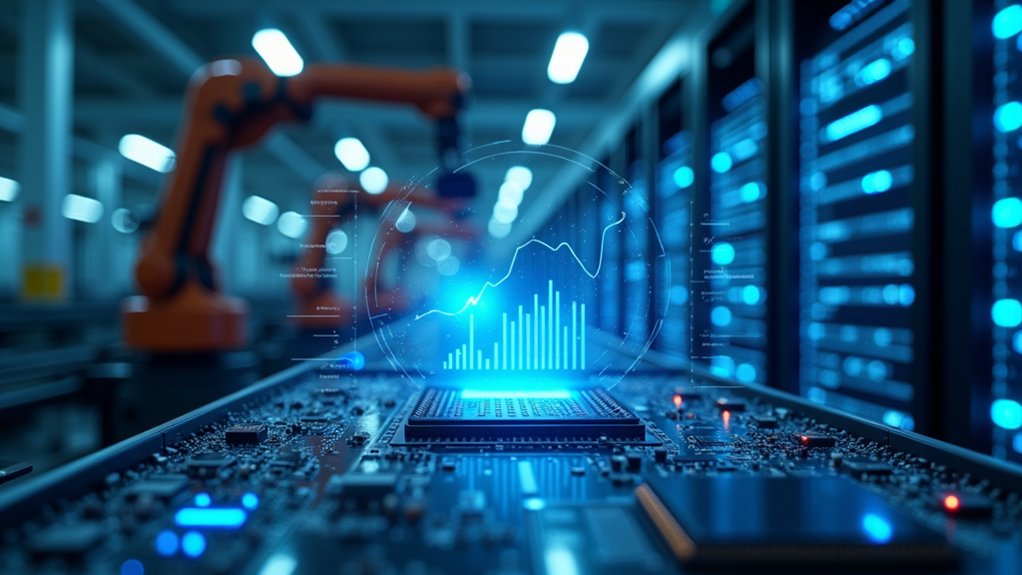How Will AI Shape the Economy?
AI is projected to reshape the global economy through substantial market growth, reaching $15.7 trillion by 2030. With 89% of small businesses already utilizing AI tools, technological adoption continues across sectors despite varying implementation success rates. Economic impacts range from PwC’s optimistic 26% GDP boost for early adopters to MIT’s conservative 1% increase, while the IMF warns that 40% of jobs face disruption. Further exploration reveals AI’s complex consequences for industries, regions, and technological infrastructure.

Transformation of global economic landscapes accelerates while artificial intelligence penetrates industrial sectors at unprecedented rates, reshaping traditional business models and productivity frameworks. Current projections indicate the AI market growing at a 37.3% CAGR between 2022 and 2030, with global revenue expected to reach $15.7 trillion by decade’s end. This expansion, though slowing from the 54% growth observed during 2019-2021 to 26% anticipated in 2025, remains robust compared to other technological sectors.
AI’s unprecedented industrial transformation promises $15.7 trillion market value by 2030 despite growth deceleration to 26% by mid-decade.
Private investments in generative AI reached $33.9 billion in recent funding rounds, representing 18.7% year-over-year growth and signaling investor confidence in AI’s commercial potential.
Corporate adoption statistics reveal 89% of small businesses now deploy AI tools for task automation and operational efficiency, while 55% of larger enterprises have incorporated AI systems into their workflows. The remaining 45% of enterprises are actively developing implementation strategies, particularly in sectors requiring extensive data analysis and customer interaction. Organizational use of AI has seen remarkable growth, with 78% of organizations reporting AI implementation in 2024, a substantial increase from 55% in 2023.
McKinsey research identifies a $4.4 trillion opportunity in optimizing supply chains and resource allocation through AI technologies, though actual realization of these benefits varies greatly by industry and implementation approach. Chinese companies stand to capture significant economic advantages as the nation is projected to control over 25% of the global AI market by 2030.
The technological infrastructure supporting AI advancement continues evolving rapidly, with projections indicating 8 billion AI voice assistants in use by 2025. Consumer behavior increasingly favors voice-based interactions, with 41% of smart device users prioritizing voice searches over text inputs. This shift necessitates continued development of sophisticated natural language processing capabilities and purpose-built AI chips capable of handling generative models and real-time processing demands.
Economic impact assessments vary considerably, with PwC projecting a 26% GDP boost for early-adopting economies while MIT models forecast a more modest 1% GDP increase over the next decade. The IMF has expressed concern that approximately 40% of global jobs face potential disruption from automation and AI technologies. Healthcare stands to experience transformative effects through predictive analytics tools that enhance clinical decision-making and improve accessibility for underserved populations.
Regional economic disparities may widen as nations with established technological infrastructure and favorable regulatory environments capture disproportionate advantages from AI incorporation across manufacturing, healthcare, financial services, and supply chain operations.
Frequently Asked Questions
Will AI Increase Income Inequality?
The impact of AI on income inequality remains uncertain and contested. Evidence suggests AI may simultaneously increase inequality through disproportionate productivity gains for high-income workers and capital owners, while potentially decreasing inequality by improving low-performers’ capabilities.
Geographic and educational disparities in AI adoption could widen gaps between countries and demographic groups. Historical technological shifts indicate AI may follow similar patterns, though recent OECD data shows no clear evidence of AI increasing wage inequality between occupations.
How Quickly Will AI Replace Human Jobs?
AI job displacement will occur at varying speeds across sectors. Current projections indicate 300 million jobs worldwide face automation risk, though complete transformation may take decades.
While 40% of employers plan workforce reductions where practicable, experts estimate automating half of global tasks requires another 20 years.
Technology and information processing sectors will experience simultaneous job creation and elimination, resulting in net displacement while AI capabilities continue advancing beyond routine cognitive and manual tasks.
Should Governments Regulate AI Development?
Government regulation of AI development represents a critical balancing act between innovation and risk mitigation.
Evidence suggests that oversight frameworks addressing ethical concerns, privacy consequences, and economic disparities are increasingly necessary while adoption accelerates.
While excessive regulation may impede the projected $15.7 trillion economic potential, insufficient governance creates vulnerabilities through misuse, bias perpetuation, and security breaches.
Sector-specific regulatory approaches that adapt with technological advancement appear most effective for managing AI’s transformative impacts on society.
How Will AI Impact Developing Economies Differently?
AI impacts developing economies through structural exclusion, infrastructure deficits, workforce disparities, and unequal benefit distribution.
Limited participation in AI governance frameworks leaves 118 nations with minimal influence over standards and regulations.
Digital infrastructure inadequacies, combined with significant skill gaps and insufficient reskilling programs, create barriers to adoption.
These challenges exacerbate existing inequalities since AI-driven productivity gains mainly benefit advanced economies and higher-income demographics, potentially widening global economic disparities.
Can Workers Successfully Transition to Ai-Complementary Roles?
Workers can successfully shift to AI-complementary roles through targeted skill development.
Data indicates that domain expertise combined with technical capabilities is essential, given the 36% growth forecast for data scientists.
While 375 million workers face displacement risks, successful shifts often yield substantial benefits, with AI-complementary positions commanding 30-40% higher compensation.
Corporate restructuring trends suggest that adaptive professionals who pursue AI ethics training and specialized skills will navigate this economic transformation more effectively.